University Assignment: Woolworths Organisational Development Report
VerifiedAdded on 2022/09/18
|11
|2080
|28
Report
AI Summary
This report provides a comprehensive analysis of Woolworths' organisational development, examining the company's history, organizational development theories, and implementation of change strategies. It delves into the internal and external factors influencing Woolworths, such as company culture, competition, and economic conditions. The report further explores strategies employed by Woolworths to affect change, including incentives, cultural value redefinition, and exercising authority. It also highlights the role of organizational structure and design in supporting the company's operations. Furthermore, the report includes a poster presentation summarizing key findings. The conclusion synthesizes the analysis, emphasizing the importance of change management, performance enhancement, and the need to address diversity impacts within the organization. The report is supported by references to relevant academic sources.
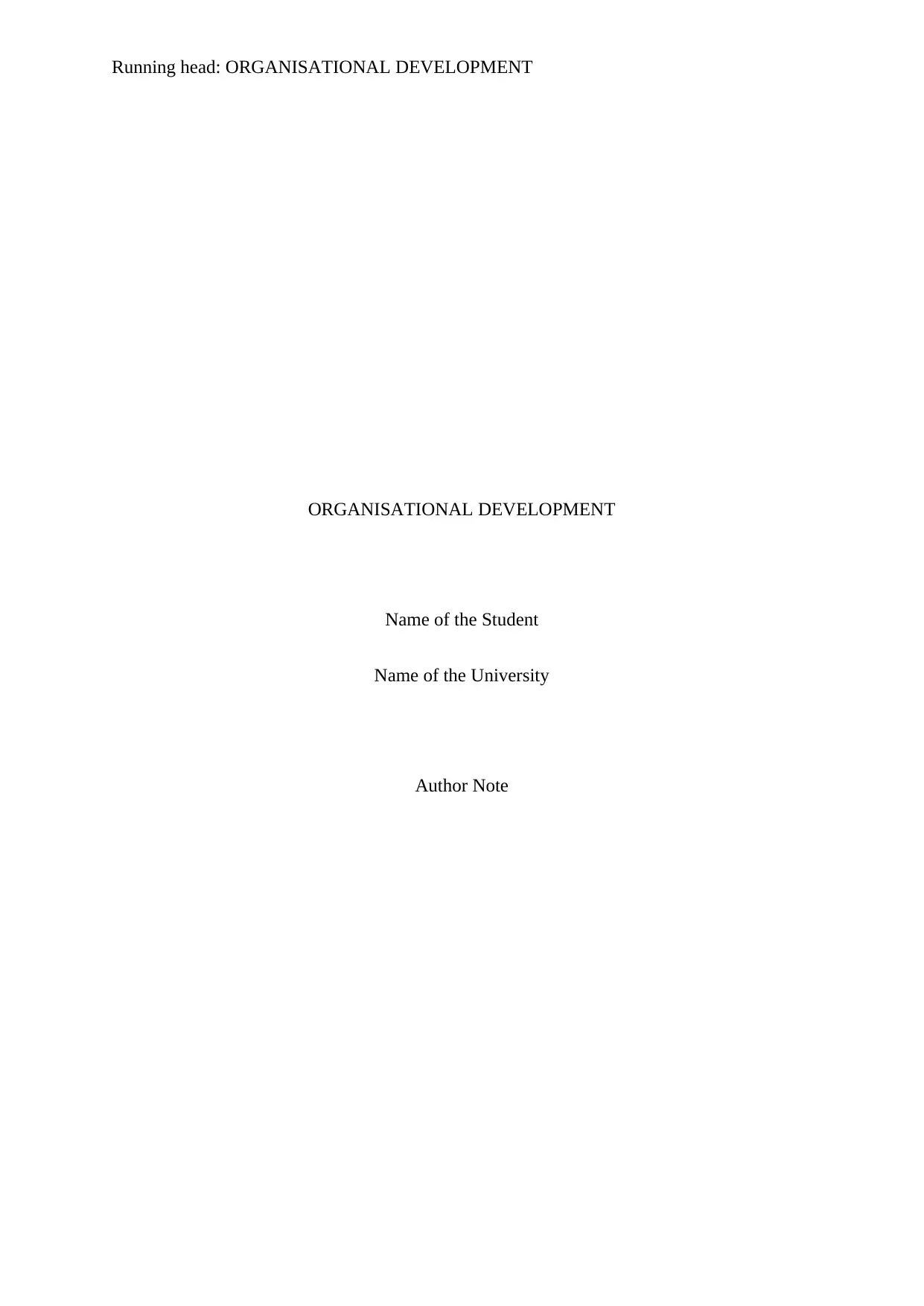
Running head: ORGANISATIONAL DEVELOPMENT
ORGANISATIONAL DEVELOPMENT
Name of the Student
Name of the University
Author Note
ORGANISATIONAL DEVELOPMENT
Name of the Student
Name of the University
Author Note
Paraphrase This Document
Need a fresh take? Get an instant paraphrase of this document with our AI Paraphraser
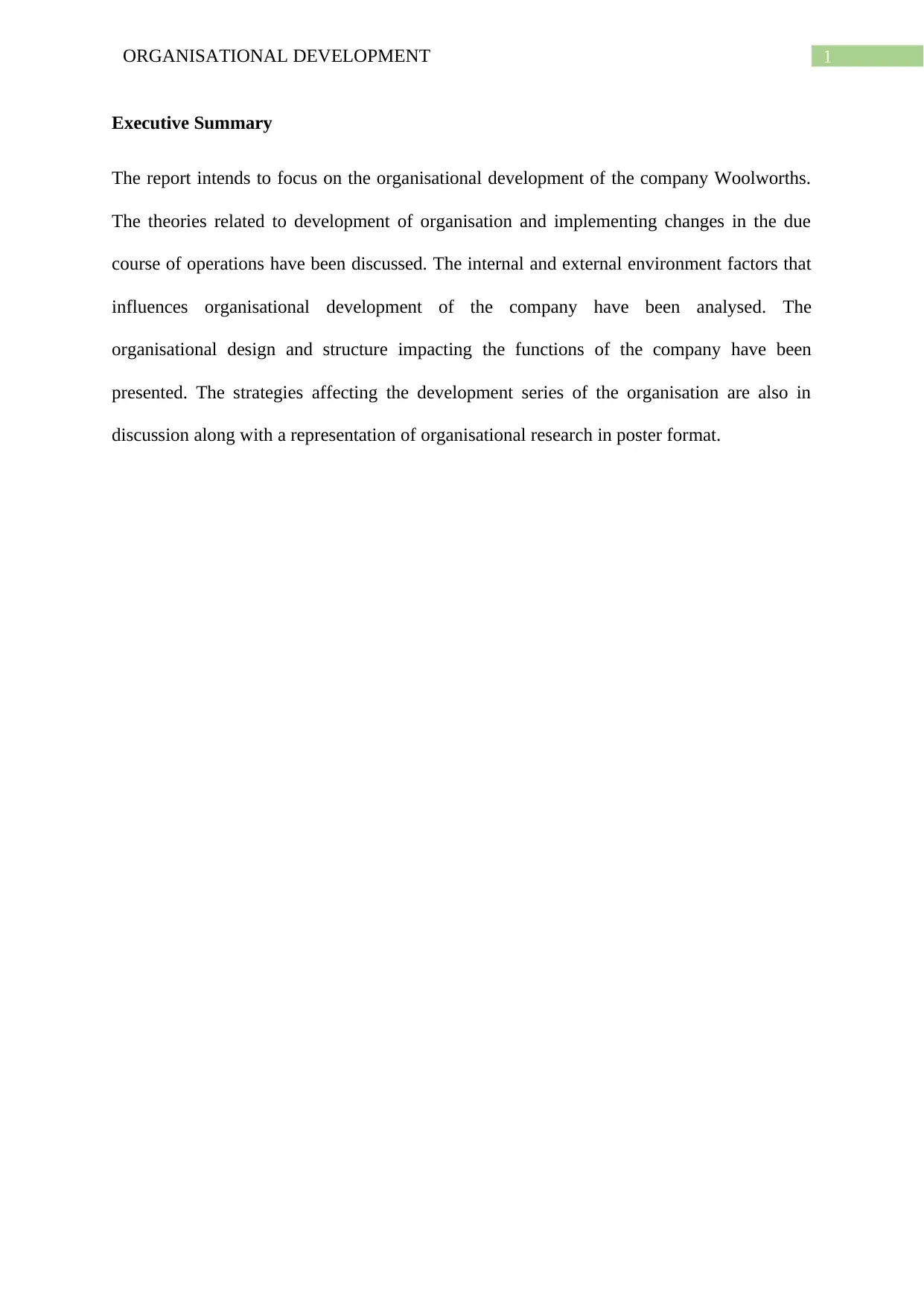
1ORGANISATIONAL DEVELOPMENT
Executive Summary
The report intends to focus on the organisational development of the company Woolworths.
The theories related to development of organisation and implementing changes in the due
course of operations have been discussed. The internal and external environment factors that
influences organisational development of the company have been analysed. The
organisational design and structure impacting the functions of the company have been
presented. The strategies affecting the development series of the organisation are also in
discussion along with a representation of organisational research in poster format.
Executive Summary
The report intends to focus on the organisational development of the company Woolworths.
The theories related to development of organisation and implementing changes in the due
course of operations have been discussed. The internal and external environment factors that
influences organisational development of the company have been analysed. The
organisational design and structure impacting the functions of the company have been
presented. The strategies affecting the development series of the organisation are also in
discussion along with a representation of organisational research in poster format.
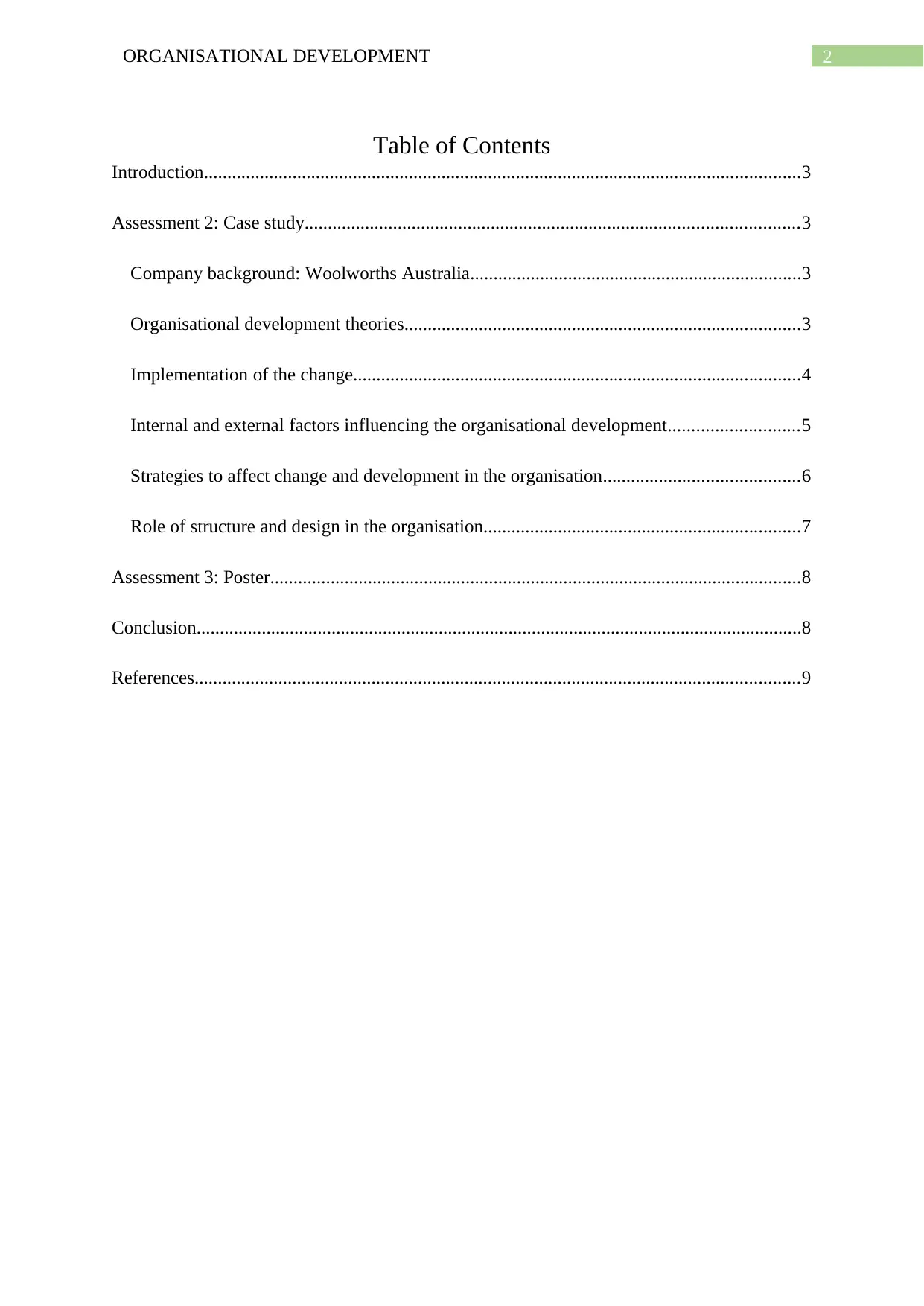
2ORGANISATIONAL DEVELOPMENT
Table of Contents
Introduction................................................................................................................................3
Assessment 2: Case study..........................................................................................................3
Company background: Woolworths Australia.......................................................................3
Organisational development theories.....................................................................................3
Implementation of the change................................................................................................4
Internal and external factors influencing the organisational development............................5
Strategies to affect change and development in the organisation..........................................6
Role of structure and design in the organisation....................................................................7
Assessment 3: Poster..................................................................................................................8
Conclusion..................................................................................................................................8
References..................................................................................................................................9
Table of Contents
Introduction................................................................................................................................3
Assessment 2: Case study..........................................................................................................3
Company background: Woolworths Australia.......................................................................3
Organisational development theories.....................................................................................3
Implementation of the change................................................................................................4
Internal and external factors influencing the organisational development............................5
Strategies to affect change and development in the organisation..........................................6
Role of structure and design in the organisation....................................................................7
Assessment 3: Poster..................................................................................................................8
Conclusion..................................................................................................................................8
References..................................................................................................................................9
⊘ This is a preview!⊘
Do you want full access?
Subscribe today to unlock all pages.

Trusted by 1+ million students worldwide
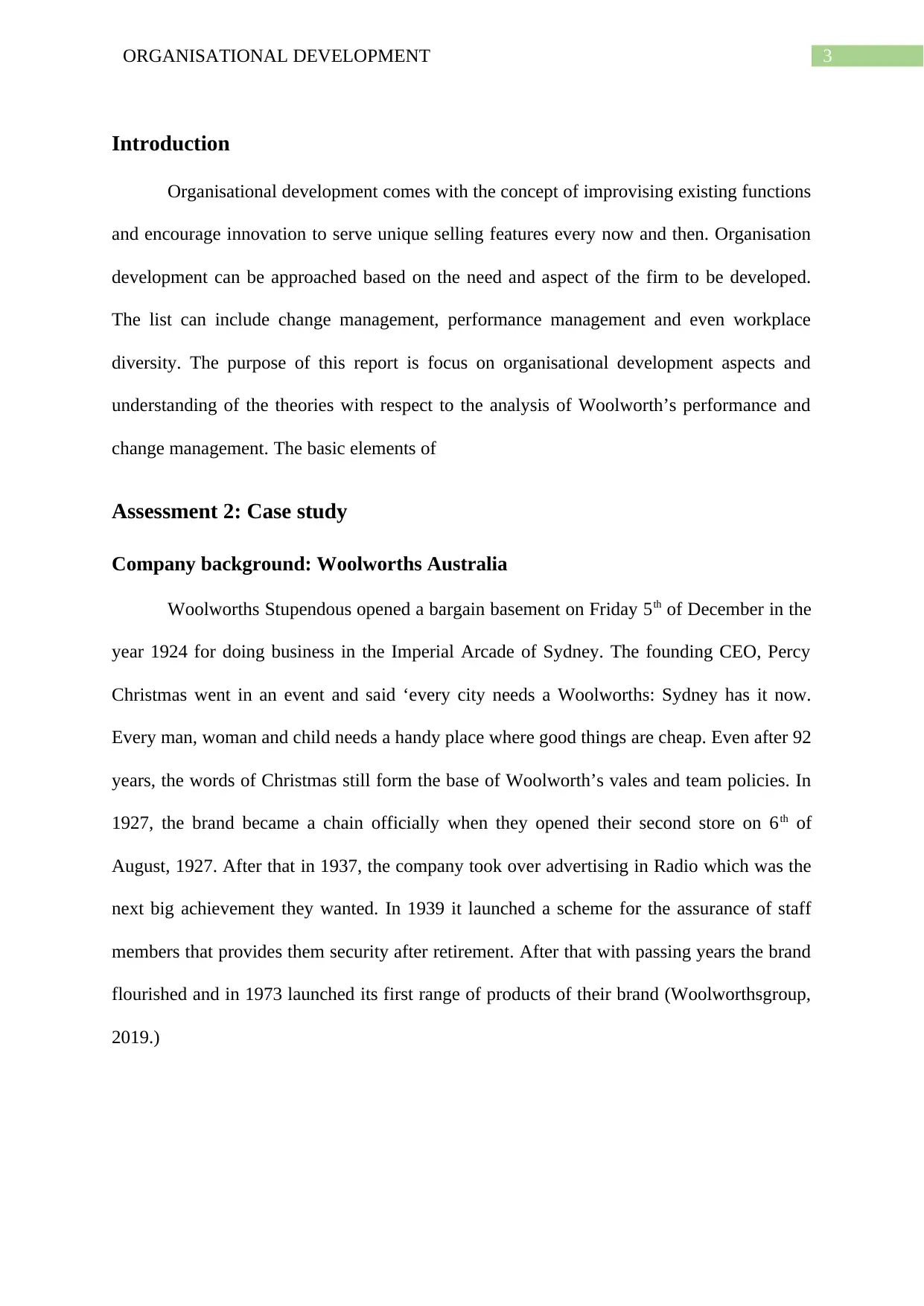
3ORGANISATIONAL DEVELOPMENT
Introduction
Organisational development comes with the concept of improvising existing functions
and encourage innovation to serve unique selling features every now and then. Organisation
development can be approached based on the need and aspect of the firm to be developed.
The list can include change management, performance management and even workplace
diversity. The purpose of this report is focus on organisational development aspects and
understanding of the theories with respect to the analysis of Woolworth’s performance and
change management. The basic elements of
Assessment 2: Case study
Company background: Woolworths Australia
Woolworths Stupendous opened a bargain basement on Friday 5th of December in the
year 1924 for doing business in the Imperial Arcade of Sydney. The founding CEO, Percy
Christmas went in an event and said ‘every city needs a Woolworths: Sydney has it now.
Every man, woman and child needs a handy place where good things are cheap. Even after 92
years, the words of Christmas still form the base of Woolworth’s vales and team policies. In
1927, the brand became a chain officially when they opened their second store on 6th of
August, 1927. After that in 1937, the company took over advertising in Radio which was the
next big achievement they wanted. In 1939 it launched a scheme for the assurance of staff
members that provides them security after retirement. After that with passing years the brand
flourished and in 1973 launched its first range of products of their brand (Woolworthsgroup,
2019.)
Introduction
Organisational development comes with the concept of improvising existing functions
and encourage innovation to serve unique selling features every now and then. Organisation
development can be approached based on the need and aspect of the firm to be developed.
The list can include change management, performance management and even workplace
diversity. The purpose of this report is focus on organisational development aspects and
understanding of the theories with respect to the analysis of Woolworth’s performance and
change management. The basic elements of
Assessment 2: Case study
Company background: Woolworths Australia
Woolworths Stupendous opened a bargain basement on Friday 5th of December in the
year 1924 for doing business in the Imperial Arcade of Sydney. The founding CEO, Percy
Christmas went in an event and said ‘every city needs a Woolworths: Sydney has it now.
Every man, woman and child needs a handy place where good things are cheap. Even after 92
years, the words of Christmas still form the base of Woolworth’s vales and team policies. In
1927, the brand became a chain officially when they opened their second store on 6th of
August, 1927. After that in 1937, the company took over advertising in Radio which was the
next big achievement they wanted. In 1939 it launched a scheme for the assurance of staff
members that provides them security after retirement. After that with passing years the brand
flourished and in 1973 launched its first range of products of their brand (Woolworthsgroup,
2019.)
Paraphrase This Document
Need a fresh take? Get an instant paraphrase of this document with our AI Paraphraser
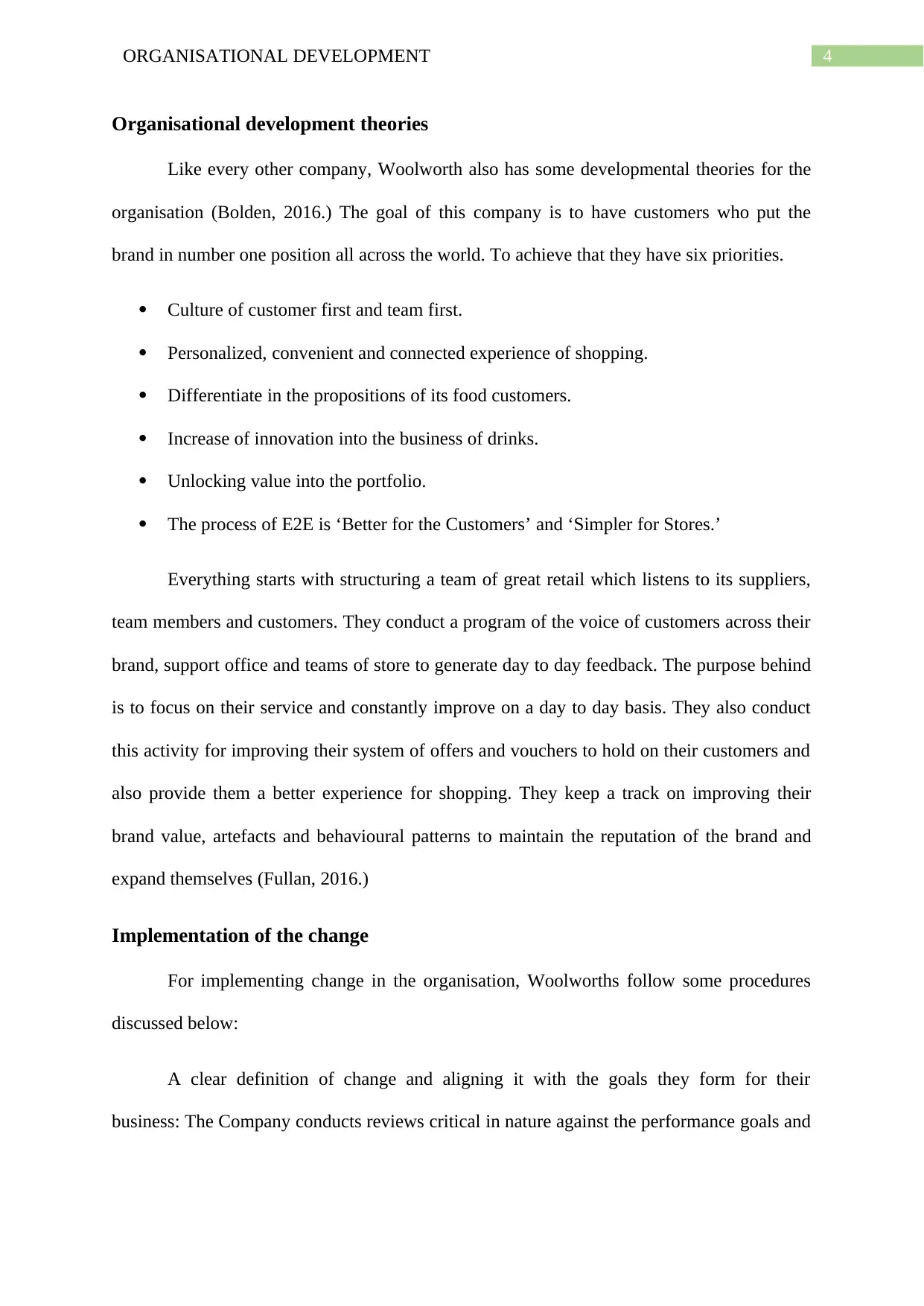
4ORGANISATIONAL DEVELOPMENT
Organisational development theories
Like every other company, Woolworth also has some developmental theories for the
organisation (Bolden, 2016.) The goal of this company is to have customers who put the
brand in number one position all across the world. To achieve that they have six priorities.
Culture of customer first and team first.
Personalized, convenient and connected experience of shopping.
Differentiate in the propositions of its food customers.
Increase of innovation into the business of drinks.
Unlocking value into the portfolio.
The process of E2E is ‘Better for the Customers’ and ‘Simpler for Stores.’
Everything starts with structuring a team of great retail which listens to its suppliers,
team members and customers. They conduct a program of the voice of customers across their
brand, support office and teams of store to generate day to day feedback. The purpose behind
is to focus on their service and constantly improve on a day to day basis. They also conduct
this activity for improving their system of offers and vouchers to hold on their customers and
also provide them a better experience for shopping. They keep a track on improving their
brand value, artefacts and behavioural patterns to maintain the reputation of the brand and
expand themselves (Fullan, 2016.)
Implementation of the change
For implementing change in the organisation, Woolworths follow some procedures
discussed below:
A clear definition of change and aligning it with the goals they form for their
business: The Company conducts reviews critical in nature against the performance goals and
Organisational development theories
Like every other company, Woolworth also has some developmental theories for the
organisation (Bolden, 2016.) The goal of this company is to have customers who put the
brand in number one position all across the world. To achieve that they have six priorities.
Culture of customer first and team first.
Personalized, convenient and connected experience of shopping.
Differentiate in the propositions of its food customers.
Increase of innovation into the business of drinks.
Unlocking value into the portfolio.
The process of E2E is ‘Better for the Customers’ and ‘Simpler for Stores.’
Everything starts with structuring a team of great retail which listens to its suppliers,
team members and customers. They conduct a program of the voice of customers across their
brand, support office and teams of store to generate day to day feedback. The purpose behind
is to focus on their service and constantly improve on a day to day basis. They also conduct
this activity for improving their system of offers and vouchers to hold on their customers and
also provide them a better experience for shopping. They keep a track on improving their
brand value, artefacts and behavioural patterns to maintain the reputation of the brand and
expand themselves (Fullan, 2016.)
Implementation of the change
For implementing change in the organisation, Woolworths follow some procedures
discussed below:
A clear definition of change and aligning it with the goals they form for their
business: The Company conducts reviews critical in nature against the performance goals and
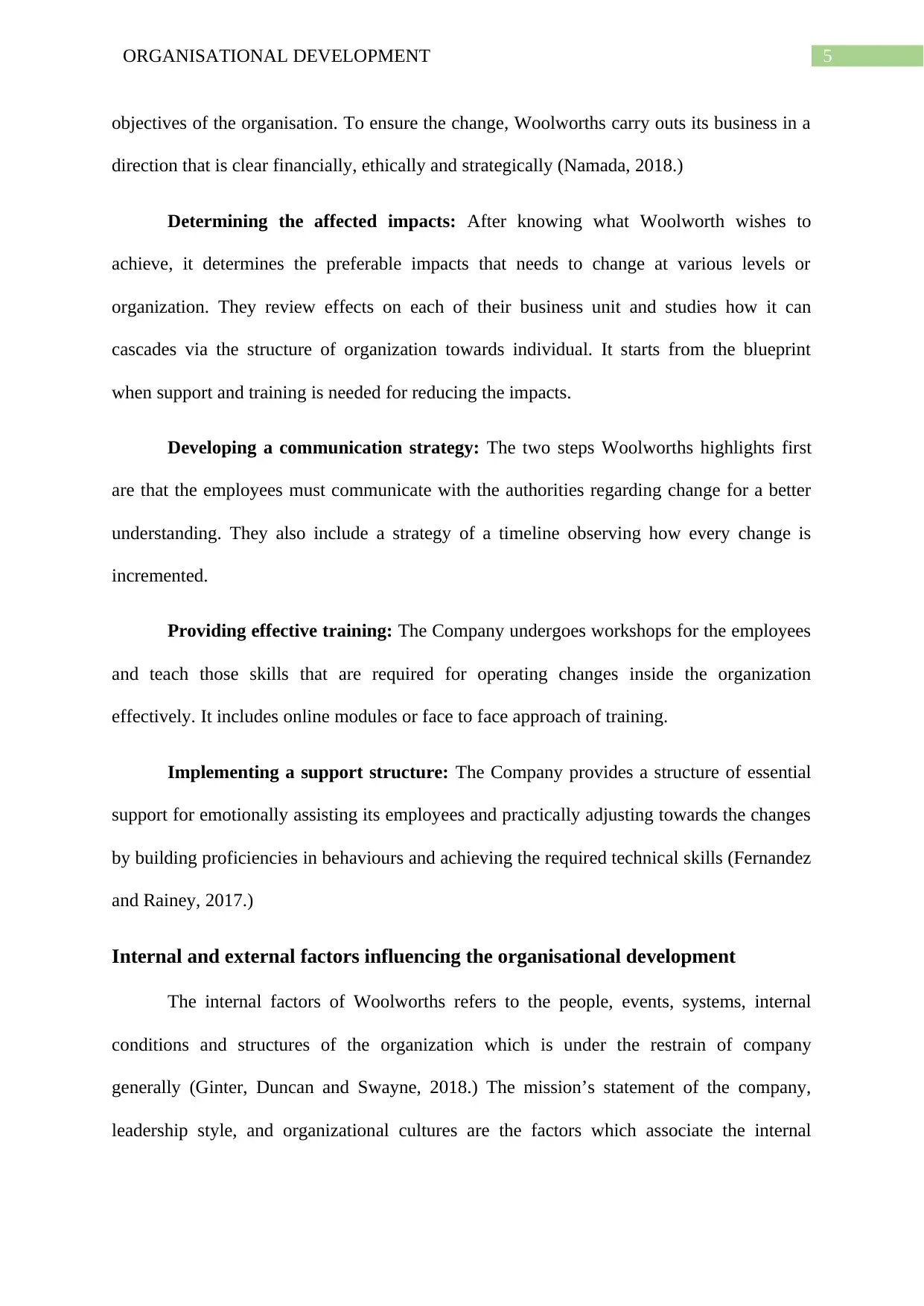
5ORGANISATIONAL DEVELOPMENT
objectives of the organisation. To ensure the change, Woolworths carry outs its business in a
direction that is clear financially, ethically and strategically (Namada, 2018.)
Determining the affected impacts: After knowing what Woolworth wishes to
achieve, it determines the preferable impacts that needs to change at various levels or
organization. They review effects on each of their business unit and studies how it can
cascades via the structure of organization towards individual. It starts from the blueprint
when support and training is needed for reducing the impacts.
Developing a communication strategy: The two steps Woolworths highlights first
are that the employees must communicate with the authorities regarding change for a better
understanding. They also include a strategy of a timeline observing how every change is
incremented.
Providing effective training: The Company undergoes workshops for the employees
and teach those skills that are required for operating changes inside the organization
effectively. It includes online modules or face to face approach of training.
Implementing a support structure: The Company provides a structure of essential
support for emotionally assisting its employees and practically adjusting towards the changes
by building proficiencies in behaviours and achieving the required technical skills (Fernandez
and Rainey, 2017.)
Internal and external factors influencing the organisational development
The internal factors of Woolworths refers to the people, events, systems, internal
conditions and structures of the organization which is under the restrain of company
generally (Ginter, Duncan and Swayne, 2018.) The mission’s statement of the company,
leadership style, and organizational cultures are the factors which associate the internal
objectives of the organisation. To ensure the change, Woolworths carry outs its business in a
direction that is clear financially, ethically and strategically (Namada, 2018.)
Determining the affected impacts: After knowing what Woolworth wishes to
achieve, it determines the preferable impacts that needs to change at various levels or
organization. They review effects on each of their business unit and studies how it can
cascades via the structure of organization towards individual. It starts from the blueprint
when support and training is needed for reducing the impacts.
Developing a communication strategy: The two steps Woolworths highlights first
are that the employees must communicate with the authorities regarding change for a better
understanding. They also include a strategy of a timeline observing how every change is
incremented.
Providing effective training: The Company undergoes workshops for the employees
and teach those skills that are required for operating changes inside the organization
effectively. It includes online modules or face to face approach of training.
Implementing a support structure: The Company provides a structure of essential
support for emotionally assisting its employees and practically adjusting towards the changes
by building proficiencies in behaviours and achieving the required technical skills (Fernandez
and Rainey, 2017.)
Internal and external factors influencing the organisational development
The internal factors of Woolworths refers to the people, events, systems, internal
conditions and structures of the organization which is under the restrain of company
generally (Ginter, Duncan and Swayne, 2018.) The mission’s statement of the company,
leadership style, and organizational cultures are the factors which associate the internal
⊘ This is a preview!⊘
Do you want full access?
Subscribe today to unlock all pages.

Trusted by 1+ million students worldwide
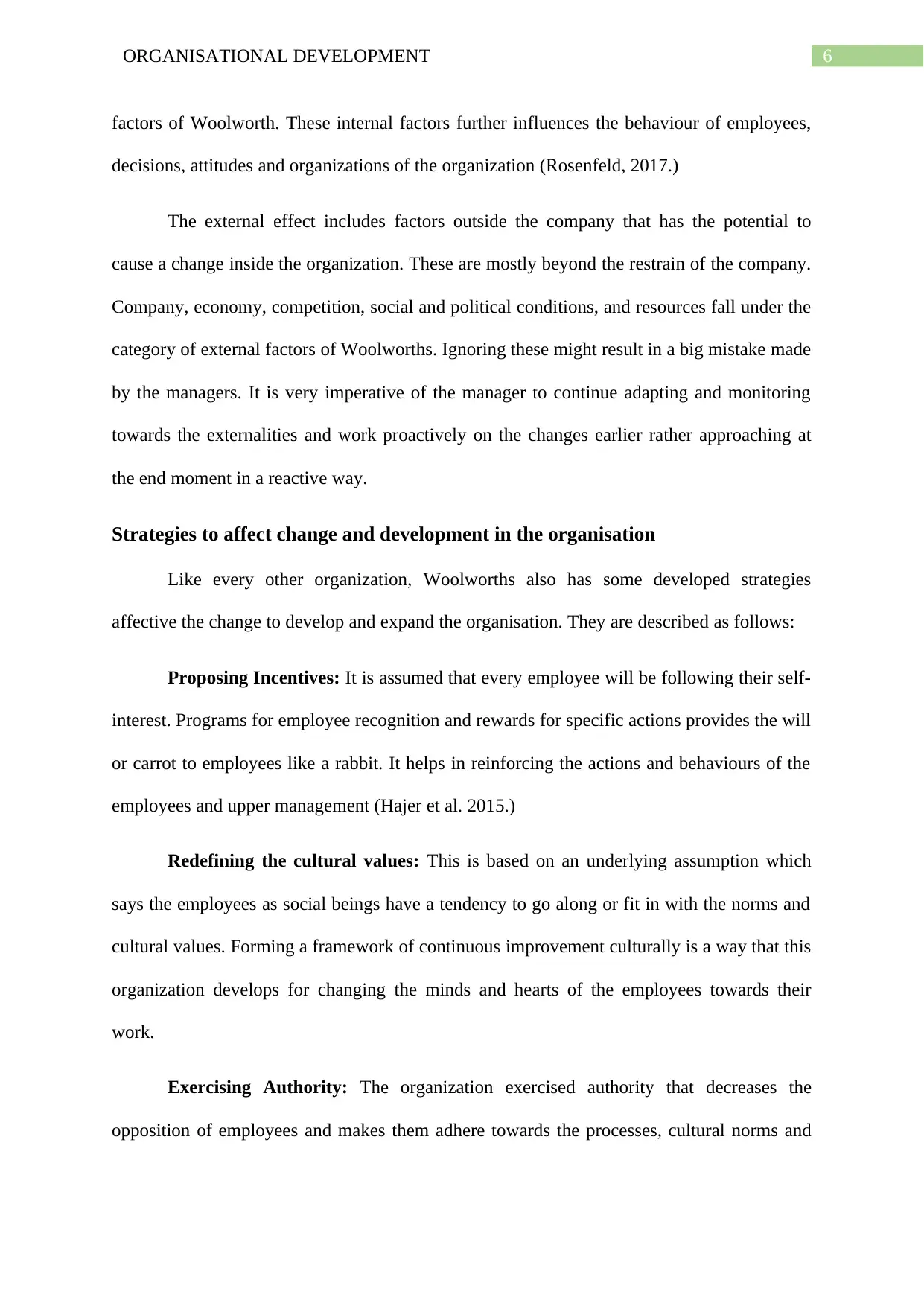
6ORGANISATIONAL DEVELOPMENT
factors of Woolworth. These internal factors further influences the behaviour of employees,
decisions, attitudes and organizations of the organization (Rosenfeld, 2017.)
The external effect includes factors outside the company that has the potential to
cause a change inside the organization. These are mostly beyond the restrain of the company.
Company, economy, competition, social and political conditions, and resources fall under the
category of external factors of Woolworths. Ignoring these might result in a big mistake made
by the managers. It is very imperative of the manager to continue adapting and monitoring
towards the externalities and work proactively on the changes earlier rather approaching at
the end moment in a reactive way.
Strategies to affect change and development in the organisation
Like every other organization, Woolworths also has some developed strategies
affective the change to develop and expand the organisation. They are described as follows:
Proposing Incentives: It is assumed that every employee will be following their self-
interest. Programs for employee recognition and rewards for specific actions provides the will
or carrot to employees like a rabbit. It helps in reinforcing the actions and behaviours of the
employees and upper management (Hajer et al. 2015.)
Redefining the cultural values: This is based on an underlying assumption which
says the employees as social beings have a tendency to go along or fit in with the norms and
cultural values. Forming a framework of continuous improvement culturally is a way that this
organization develops for changing the minds and hearts of the employees towards their
work.
Exercising Authority: The organization exercised authority that decreases the
opposition of employees and makes them adhere towards the processes, cultural norms and
factors of Woolworth. These internal factors further influences the behaviour of employees,
decisions, attitudes and organizations of the organization (Rosenfeld, 2017.)
The external effect includes factors outside the company that has the potential to
cause a change inside the organization. These are mostly beyond the restrain of the company.
Company, economy, competition, social and political conditions, and resources fall under the
category of external factors of Woolworths. Ignoring these might result in a big mistake made
by the managers. It is very imperative of the manager to continue adapting and monitoring
towards the externalities and work proactively on the changes earlier rather approaching at
the end moment in a reactive way.
Strategies to affect change and development in the organisation
Like every other organization, Woolworths also has some developed strategies
affective the change to develop and expand the organisation. They are described as follows:
Proposing Incentives: It is assumed that every employee will be following their self-
interest. Programs for employee recognition and rewards for specific actions provides the will
or carrot to employees like a rabbit. It helps in reinforcing the actions and behaviours of the
employees and upper management (Hajer et al. 2015.)
Redefining the cultural values: This is based on an underlying assumption which
says the employees as social beings have a tendency to go along or fit in with the norms and
cultural values. Forming a framework of continuous improvement culturally is a way that this
organization develops for changing the minds and hearts of the employees towards their
work.
Exercising Authority: The organization exercised authority that decreases the
opposition of employees and makes them adhere towards the processes, cultural norms and
Paraphrase This Document
Need a fresh take? Get an instant paraphrase of this document with our AI Paraphraser
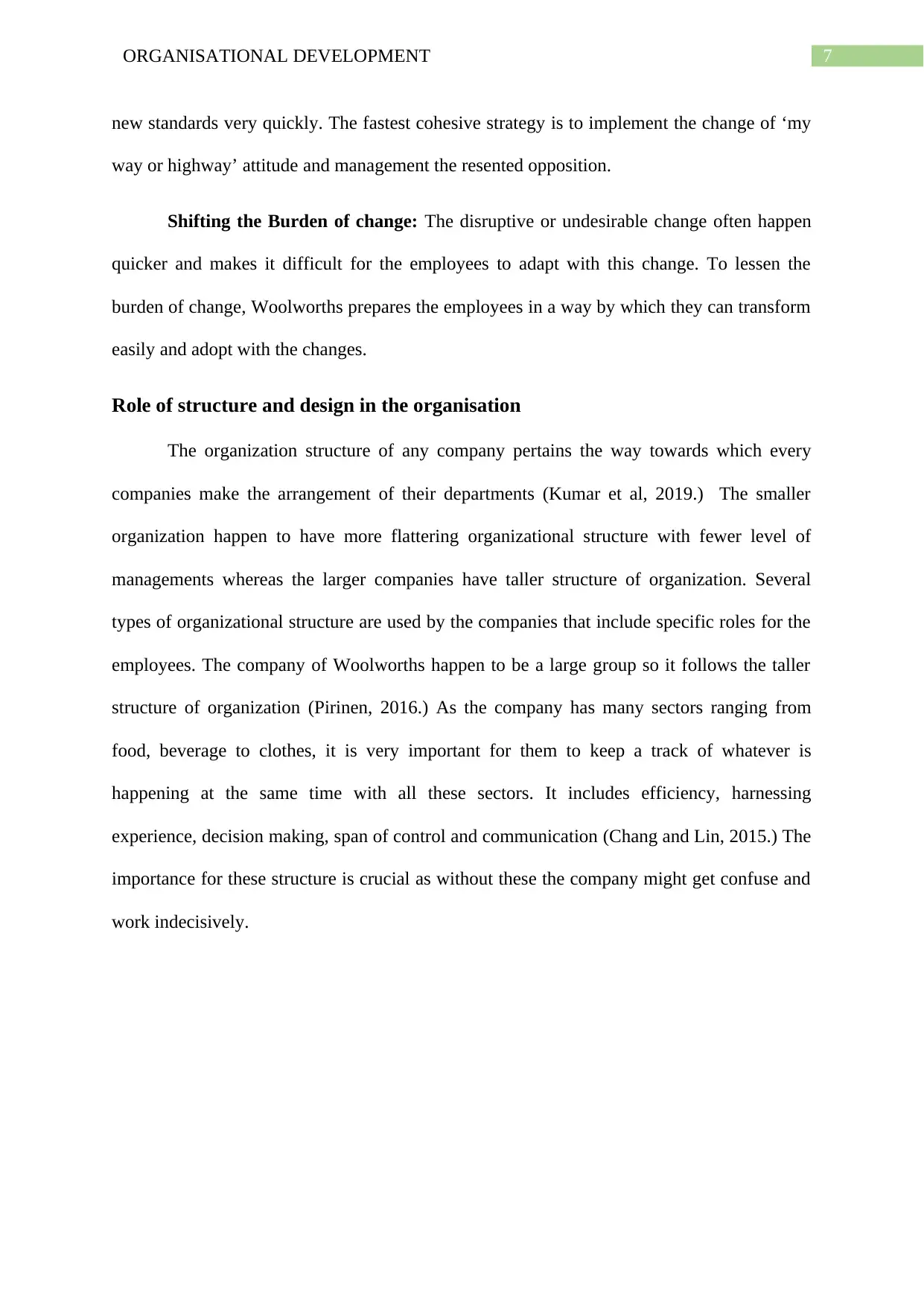
7ORGANISATIONAL DEVELOPMENT
new standards very quickly. The fastest cohesive strategy is to implement the change of ‘my
way or highway’ attitude and management the resented opposition.
Shifting the Burden of change: The disruptive or undesirable change often happen
quicker and makes it difficult for the employees to adapt with this change. To lessen the
burden of change, Woolworths prepares the employees in a way by which they can transform
easily and adopt with the changes.
Role of structure and design in the organisation
The organization structure of any company pertains the way towards which every
companies make the arrangement of their departments (Kumar et al, 2019.) The smaller
organization happen to have more flattering organizational structure with fewer level of
managements whereas the larger companies have taller structure of organization. Several
types of organizational structure are used by the companies that include specific roles for the
employees. The company of Woolworths happen to be a large group so it follows the taller
structure of organization (Pirinen, 2016.) As the company has many sectors ranging from
food, beverage to clothes, it is very important for them to keep a track of whatever is
happening at the same time with all these sectors. It includes efficiency, harnessing
experience, decision making, span of control and communication (Chang and Lin, 2015.) The
importance for these structure is crucial as without these the company might get confuse and
work indecisively.
new standards very quickly. The fastest cohesive strategy is to implement the change of ‘my
way or highway’ attitude and management the resented opposition.
Shifting the Burden of change: The disruptive or undesirable change often happen
quicker and makes it difficult for the employees to adapt with this change. To lessen the
burden of change, Woolworths prepares the employees in a way by which they can transform
easily and adopt with the changes.
Role of structure and design in the organisation
The organization structure of any company pertains the way towards which every
companies make the arrangement of their departments (Kumar et al, 2019.) The smaller
organization happen to have more flattering organizational structure with fewer level of
managements whereas the larger companies have taller structure of organization. Several
types of organizational structure are used by the companies that include specific roles for the
employees. The company of Woolworths happen to be a large group so it follows the taller
structure of organization (Pirinen, 2016.) As the company has many sectors ranging from
food, beverage to clothes, it is very important for them to keep a track of whatever is
happening at the same time with all these sectors. It includes efficiency, harnessing
experience, decision making, span of control and communication (Chang and Lin, 2015.) The
importance for these structure is crucial as without these the company might get confuse and
work indecisively.
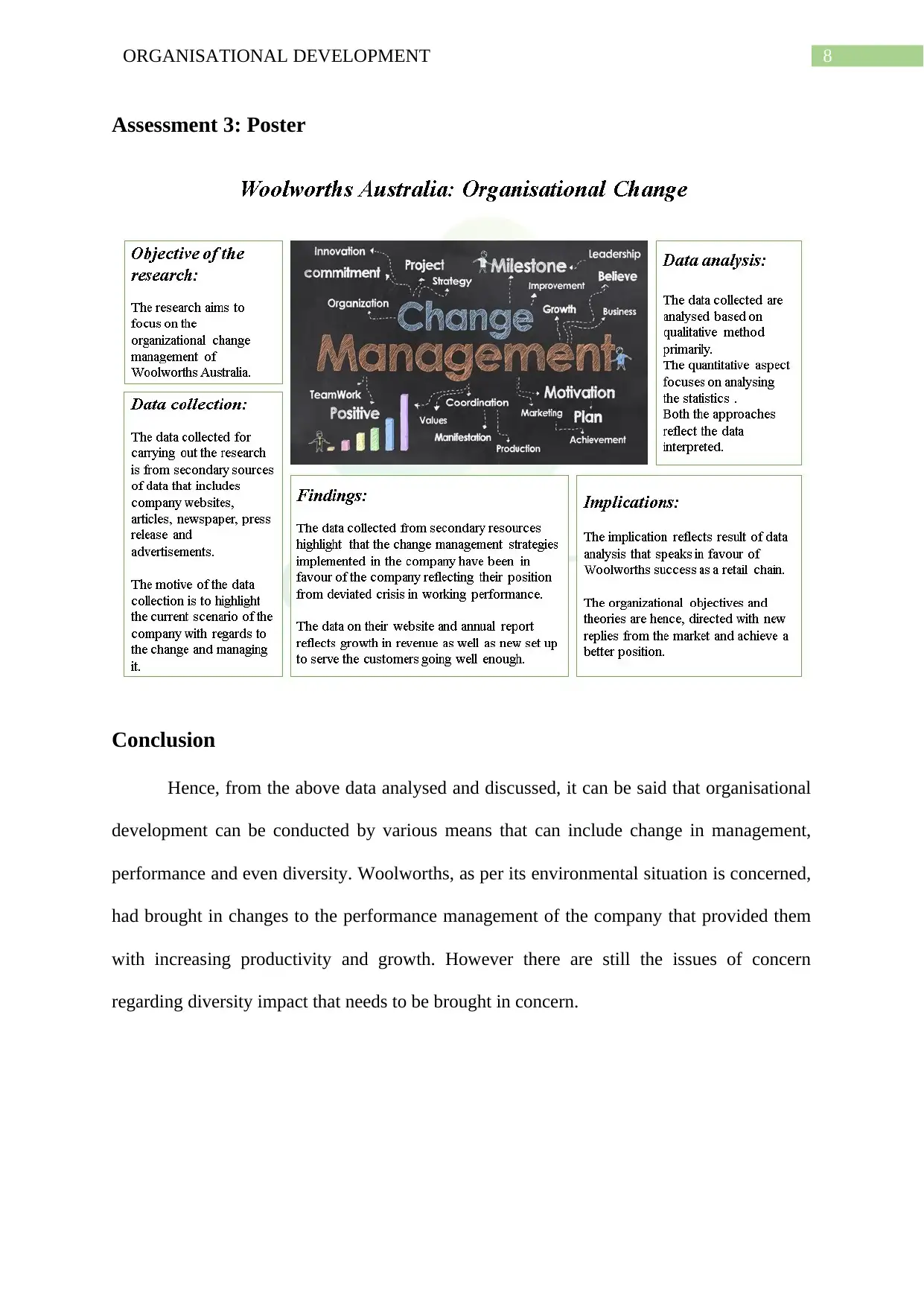
8ORGANISATIONAL DEVELOPMENT
Assessment 3: Poster
Conclusion
Hence, from the above data analysed and discussed, it can be said that organisational
development can be conducted by various means that can include change in management,
performance and even diversity. Woolworths, as per its environmental situation is concerned,
had brought in changes to the performance management of the company that provided them
with increasing productivity and growth. However there are still the issues of concern
regarding diversity impact that needs to be brought in concern.
Assessment 3: Poster
Conclusion
Hence, from the above data analysed and discussed, it can be said that organisational
development can be conducted by various means that can include change in management,
performance and even diversity. Woolworths, as per its environmental situation is concerned,
had brought in changes to the performance management of the company that provided them
with increasing productivity and growth. However there are still the issues of concern
regarding diversity impact that needs to be brought in concern.
⊘ This is a preview!⊘
Do you want full access?
Subscribe today to unlock all pages.

Trusted by 1+ million students worldwide
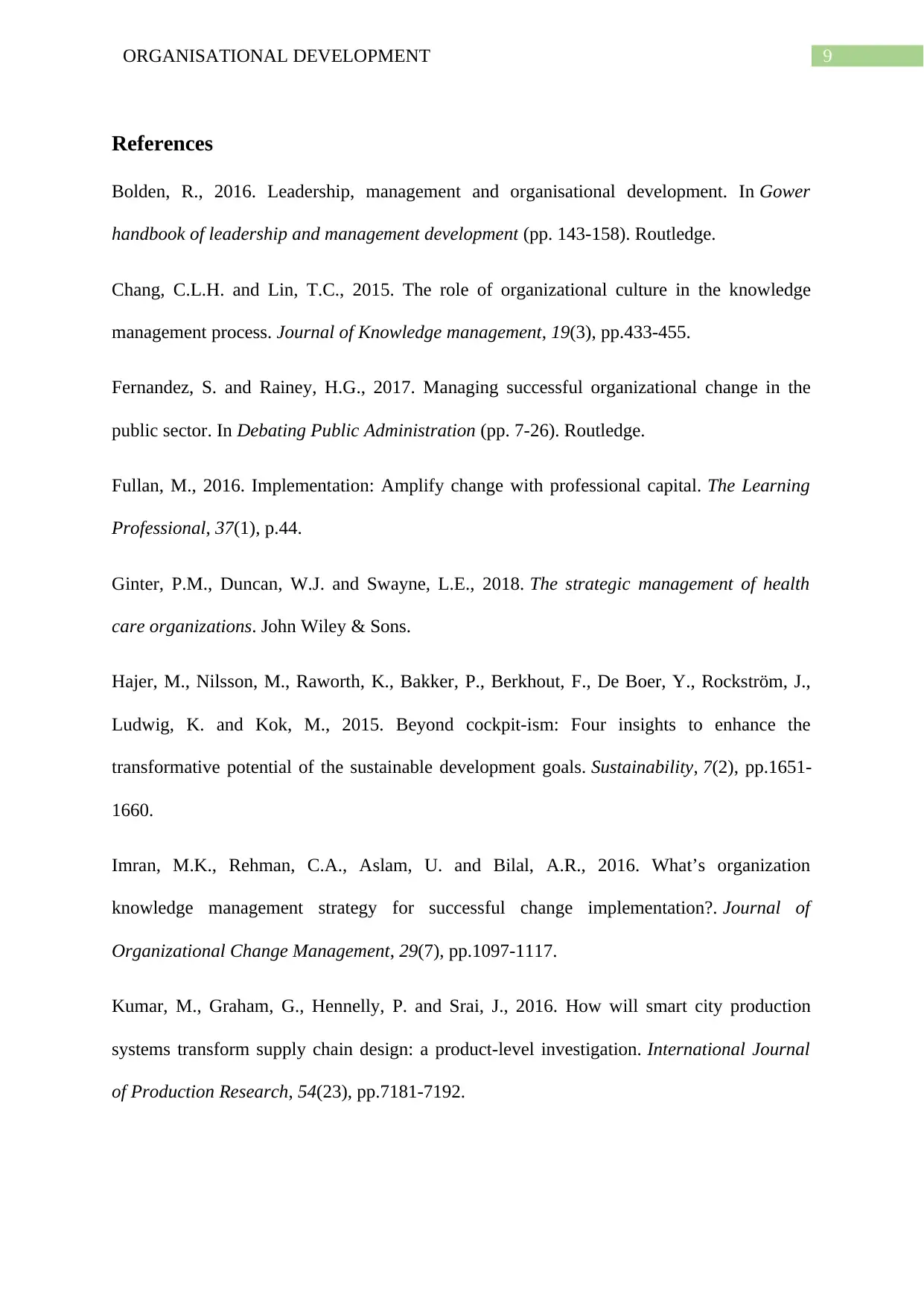
9ORGANISATIONAL DEVELOPMENT
References
Bolden, R., 2016. Leadership, management and organisational development. In Gower
handbook of leadership and management development (pp. 143-158). Routledge.
Chang, C.L.H. and Lin, T.C., 2015. The role of organizational culture in the knowledge
management process. Journal of Knowledge management, 19(3), pp.433-455.
Fernandez, S. and Rainey, H.G., 2017. Managing successful organizational change in the
public sector. In Debating Public Administration (pp. 7-26). Routledge.
Fullan, M., 2016. Implementation: Amplify change with professional capital. The Learning
Professional, 37(1), p.44.
Ginter, P.M., Duncan, W.J. and Swayne, L.E., 2018. The strategic management of health
care organizations. John Wiley & Sons.
Hajer, M., Nilsson, M., Raworth, K., Bakker, P., Berkhout, F., De Boer, Y., Rockström, J.,
Ludwig, K. and Kok, M., 2015. Beyond cockpit-ism: Four insights to enhance the
transformative potential of the sustainable development goals. Sustainability, 7(2), pp.1651-
1660.
Imran, M.K., Rehman, C.A., Aslam, U. and Bilal, A.R., 2016. What’s organization
knowledge management strategy for successful change implementation?. Journal of
Organizational Change Management, 29(7), pp.1097-1117.
Kumar, M., Graham, G., Hennelly, P. and Srai, J., 2016. How will smart city production
systems transform supply chain design: a product-level investigation. International Journal
of Production Research, 54(23), pp.7181-7192.
References
Bolden, R., 2016. Leadership, management and organisational development. In Gower
handbook of leadership and management development (pp. 143-158). Routledge.
Chang, C.L.H. and Lin, T.C., 2015. The role of organizational culture in the knowledge
management process. Journal of Knowledge management, 19(3), pp.433-455.
Fernandez, S. and Rainey, H.G., 2017. Managing successful organizational change in the
public sector. In Debating Public Administration (pp. 7-26). Routledge.
Fullan, M., 2016. Implementation: Amplify change with professional capital. The Learning
Professional, 37(1), p.44.
Ginter, P.M., Duncan, W.J. and Swayne, L.E., 2018. The strategic management of health
care organizations. John Wiley & Sons.
Hajer, M., Nilsson, M., Raworth, K., Bakker, P., Berkhout, F., De Boer, Y., Rockström, J.,
Ludwig, K. and Kok, M., 2015. Beyond cockpit-ism: Four insights to enhance the
transformative potential of the sustainable development goals. Sustainability, 7(2), pp.1651-
1660.
Imran, M.K., Rehman, C.A., Aslam, U. and Bilal, A.R., 2016. What’s organization
knowledge management strategy for successful change implementation?. Journal of
Organizational Change Management, 29(7), pp.1097-1117.
Kumar, M., Graham, G., Hennelly, P. and Srai, J., 2016. How will smart city production
systems transform supply chain design: a product-level investigation. International Journal
of Production Research, 54(23), pp.7181-7192.
Paraphrase This Document
Need a fresh take? Get an instant paraphrase of this document with our AI Paraphraser
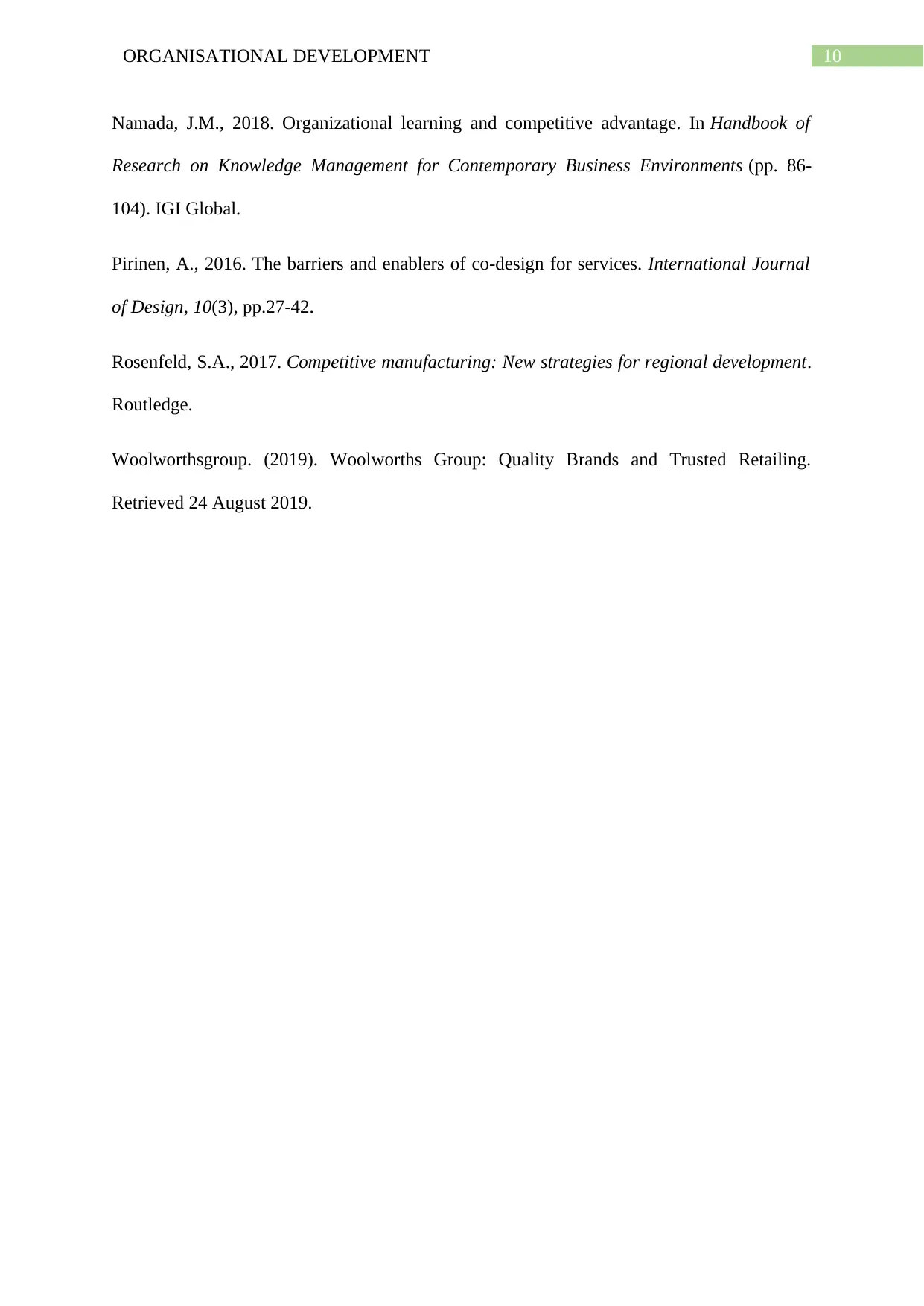
10ORGANISATIONAL DEVELOPMENT
Namada, J.M., 2018. Organizational learning and competitive advantage. In Handbook of
Research on Knowledge Management for Contemporary Business Environments (pp. 86-
104). IGI Global.
Pirinen, A., 2016. The barriers and enablers of co-design for services. International Journal
of Design, 10(3), pp.27-42.
Rosenfeld, S.A., 2017. Competitive manufacturing: New strategies for regional development.
Routledge.
Woolworthsgroup. (2019). Woolworths Group: Quality Brands and Trusted Retailing.
Retrieved 24 August 2019.
Namada, J.M., 2018. Organizational learning and competitive advantage. In Handbook of
Research on Knowledge Management for Contemporary Business Environments (pp. 86-
104). IGI Global.
Pirinen, A., 2016. The barriers and enablers of co-design for services. International Journal
of Design, 10(3), pp.27-42.
Rosenfeld, S.A., 2017. Competitive manufacturing: New strategies for regional development.
Routledge.
Woolworthsgroup. (2019). Woolworths Group: Quality Brands and Trusted Retailing.
Retrieved 24 August 2019.
1 out of 11
Related Documents
Your All-in-One AI-Powered Toolkit for Academic Success.
+13062052269
info@desklib.com
Available 24*7 on WhatsApp / Email
![[object Object]](/_next/static/media/star-bottom.7253800d.svg)
Unlock your academic potential
Copyright © 2020–2025 A2Z Services. All Rights Reserved. Developed and managed by ZUCOL.




![Strategic Marketing Management Report: Woolworths, [University Name]](/_next/image/?url=https%3A%2F%2Fdesklib.com%2Fmedia%2Fimages%2Frd%2Fa540a2dbeef8466fa936dcad0b009d06.jpg&w=256&q=75)
